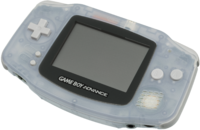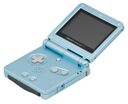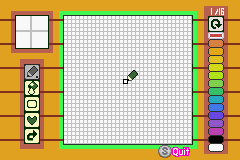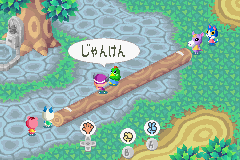Difference between revisions of "Game Boy Advance"
PanchamBro (talk | contribs) (replacing with svg) |
AlexBot2004 (talk | contribs) |
||
| (11 intermediate revisions by 3 users not shown) | |||
| Line 17: | Line 17: | ||
| discontinued = {{Flag|JPN}} Q4 2006<br>{{Flag|USA}} May 15, 2010<br>{{Flag|EUR}} Q4 2008<br>{{Flag|AUS}} Q4 2008 | | discontinued = {{Flag|JPN}} Q4 2006<br>{{Flag|USA}} May 15, 2010<br>{{Flag|EUR}} Q4 2008<br>{{Flag|AUS}} Q4 2008 | ||
| media = Game Boy, Game Boy Color, and Game Boy Advance Game Paks | | media = Game Boy, Game Boy Color, and Game Boy Advance Game Paks | ||
| − | | input = | + | | input = +Control Pad, face buttons |
| predecessor = [[nintendowiki:Game Boy Color|Game Boy Color]] | | predecessor = [[nintendowiki:Game Boy Color|Game Boy Color]] | ||
| successor = [[Nintendo DS]] | | successor = [[Nintendo DS]] | ||
}} | }} | ||
| − | The '''Game Boy Advance''' | + | The '''Game Boy Advance''' ('''GBA''') is a handheld video game console made by [[Nintendo]] and released in 2001. While no ''[[Animal Crossing (series)|Animal Crossing]]'' games were released for the Game Boy Advance, {{DnM+}}, {{PG}}, and {{DnMe+}} feature GBA connectivity via the [[Nintendo GameCube]]–Game Boy Advance link cable. Additionally, several series of [[e-Reader card]]s for the aforementioned games were released for the GBA's [[e-Reader]] accessory. |
| − | + | The GBA sold a total of 81.51 million units worldwide.<ref>{{Cite web|author=Nintendo|url=https://www.nintendo.co.jp/ir/en/finance/hard_soft/index.html|title=IR Information : Sales Data - Dedicated Video Game Sales Units|site=nintendo.co.jp|retrieved=August 24, 2021}}</ref> It was succeeded by the [[Nintendo DS]] in 2004. | |
| − | The GBA | + | ==''Animal Crossing'' content== |
| + | ===Advance Play=== | ||
| + | In {{PG|nolink}} and {{DnMe+|nolink}}, when interacting with an [[NES game]] item while a Game Boy Advance is connected to the Nintendo GameCube, the Advance Play option appears. Advance Play downloads the NES game's data to the GBA and allows it to be played there. Afterward, the GBA can be disconnected to the GameCube; it can be reconnected to transfer data back to the GameCube to save progress. | ||
| + | |||
| + | {{I|Clu Clu Land D|PG|''Clu Clu Land D''}}, {{I|Punchout|PG|''Punch-Out!!''}}, {{I|Wario's Woods|PG|''Wario's Woods''}}, and the unobtainable {{I|Legend of Zelda|PG|''The Legend of Zelda''}} do not support Advance Play as they are too large to be stored in the GBA's RAM. | ||
| + | |||
| + | ===''Animal Island''=== | ||
| + | {{Main|Animal Island (minigame)}} | ||
| + | [[File:AI Fishing.png|thumb|left|[[Faith]] fishing on the GBA island]] | ||
| + | In {{DnM+|nolink}} and {{PG|nolink}}, [[Animal Island]] can only be accessed while a Game Boy Advance is connected to the Nintendo GameCube. When on the island, when the player asks [[Kapp'n]] to return to the mainland, he gives them the option to save the island to the GBA. If the player does this, the {{AI}} minigame appears on the GBA. In the minigame, the player can interact with the [[islander]], helping them catch fish, eat fruits or coconuts left on the ground, dig up buried items, chop down trees, or catch flying presents. The next time the player visits the island, any changes made to the island in the minigame are uploaded to the GameCube. | ||
| + | |||
| + | In {{DnMe+|nolink}}, the ''Animal Island'' minigame is removed, as the island no longer requires a GBA connection to visit and is instead unlocked after paying off a [[Home loan|loan]]. | ||
| + | {{Clear|left}} | ||
| + | |||
| + | ===Design maker=== | ||
| + | {{Section}} | ||
| + | [[File:PG Design Window GBA.png|thumb|left|The design editor on the GBA]] | ||
| + | In {{DnM+|nolink}}, {{PG|nolink}}, and {{DnMe+|nolink}}, the player can create and edit [[design]]s on the Game Boy Advance if one is connected to the Nintendo GameCube when speaking to [[Mabel]] at the [[Able Sisters]]. | ||
| + | {{Clear}} | ||
| + | |||
| + | ===''Doubutsu no Mori e+: Doubutsu-tachi to Asobou!''=== | ||
| + | {{Main|Doubutsu no Mori e+: Doubutsu-tachi to Asobou!}} | ||
| + | [[File:DnMe+DtA Donjanken.png|thumb|left|The Donjanken ''Doubutsu-tachi to Asobou!'' minigame]] | ||
| + | In {{DnMe+}}, the player can access one of three minigames, collectively known as ''[[Doubutsu no Mori e+: Doubutsu-tachi to Asobou!]]'', from the [[wishing well]] while a is a collection of three Game Boy Advance minigames that can be accessed from the [[wishing well]] while a GBA is connected to the Nintendo GameCube. These minigames feature villagers from the player's town alongside the player, and if won, the player receives one of 18 exclusive [[furniture]] items. | ||
| + | {{Clear}} | ||
| + | |||
| + | ===e-Reader=== | ||
| + | {{Main|e-Reader|e-Reader card}} | ||
| + | The [[e-Reader]] is an accessory for the Game Boy Advance that can read special scannable [[E-Reader card|cards]], which transfer data to GBA. Multiple series of cards were released for {{DnM+|nolink}}, {{PG|nolink}}, and {{DnMe+|nolink}}. In {{PG|nolink}} and {{DnMe+|nolink}}, a GBA with an e-Reader can be connected to the GameCube for additional features. | ||
==Models== | ==Models== | ||
| Line 32: | Line 60: | ||
! Name | ! Name | ||
! Image | ! Image | ||
| − | ! | + | ! Release dates |
| − | |||
| − | |||
| − | |||
! Notes | ! Notes | ||
|- | |- | ||
| − | | Game Boy Advance || [[File:Game Boy Advance.png| | + | | Game Boy Advance || [[File:Game Boy Advance.png|128px]] || {{Flag|JPN}} March 21, 2001<br>{{Flag|USA}} June 11, 2001<br>{{Flag|EUR}} June 22, 2001<br>{{Flag|AUS}} June 22, 2001<br>{{Flag|CHN}} June 8, 2004 || Original model of the Game Boy Advance. |
|- | |- | ||
| − | | Game Boy Advance SP (AGS-001) || [[File:Game Boy Advance SP.png| | + | | Game Boy Advance SP (AGS-001) || [[File:Game Boy Advance SP.png|128px]] || {{Flag|JPN}} February 14, 2003<br>{{Flag|USA}} March 23, 2003<br>{{Flag|EUR}} March 28, 2003<br>{{Flag|AUS}} March 28, 2003 || A model of the GBA that incorporates a clamshell design and a front-lit screen but removes the headphone jack. |
|- | |- | ||
| − | | Game Boy Advance SP (AGS-101) || [[File:Game Boy Advance SP 101.jpg| | + | | Game Boy Advance SP (AGS-101) || [[File:Game Boy Advance SP 101.jpg|128px]] || {{Flag|JPN}} Not released<br>{{Flag|USA}} September 2005<br>{{Flag|EUR}} 2006<br>{{Flag|AUS}} ??? || An updated version of the original GBA SP that features a backlit screen. |
|- | |- | ||
| − | | Game Boy Micro || || September 13, 2005 | | + | | Game Boy Micro || [[File:Nia.png|128px]] || {{Flag|JPN}} September 13, 2005<br>{{Flag|USA}} September 19, 2005<br>{{Flag|EUR}} November 4, 2005<br>{{Flag|AUS}} November 3, 2005<br>{{Flag|CHN}} October 1, 2005 || A more affordable and compact GBA model that lacks backwards compatibility with Game Boy and Game Boy Color games. This model is not compatible with the [[e-Reader]] |
|} | |} | ||
==Gallery== | ==Gallery== | ||
<gallery> | <gallery> | ||
| − | + | GBAConnectivityDiagram.png|A diagram depicting Game Boy Advance connectivity with the Nintendo GameCube in {{DnM+}} | |
| − | + | DnM+ GBA Insert.png|An insert included with {{DnM+|nolink}} that explains the game's GBA connectivity for {{AI}} | |
| − | + | DnMe+ Box Back.png|The back cover of {{DnMe+}}, which shows Advance Play and ''Doubutsu-tachi to Asobou!'' | |
</gallery> | </gallery> | ||
| Line 61: | Line 86: | ||
|align = left | |align = left | ||
|bulbapedia = 1 | |bulbapedia = 1 | ||
| − | |||
| − | |||
|fireemblem = 1 | |fireemblem = 1 | ||
|fzero = 1 | |fzero = 1 | ||
| Line 79: | Line 102: | ||
}} | }} | ||
| − | {{ | + | {{Navbox System and Peripherals}} |
| − | |||
Latest revision as of 18:10, January 29, 2024
|
| |||||||||||||||||
 The original Game Boy Advance | |||||||||||||||||
Available colors:
| |||||||||||||||||
| Manufacturer | Nintendo | ||||||||||||||||
|---|---|---|---|---|---|---|---|---|---|---|---|---|---|---|---|---|---|
| Type | Handheld | ||||||||||||||||
| Release date(s) | |||||||||||||||||
| Discontinued | |||||||||||||||||
| Media | Game Boy, Game Boy Color, and Game Boy Advance Game Paks | ||||||||||||||||
| Input | +Control Pad, face buttons | ||||||||||||||||
| Predecessor | Game Boy Color | ||||||||||||||||
| Successor | Nintendo DS | ||||||||||||||||
The Game Boy Advance (GBA) is a handheld video game console made by Nintendo and released in 2001. While no Animal Crossing games were released for the Game Boy Advance, Doubutsu no Mori+, Animal Crossing, and Doubutsu no Mori e+ feature GBA connectivity via the Nintendo GameCube–Game Boy Advance link cable. Additionally, several series of e-Reader cards for the aforementioned games were released for the GBA's e-Reader accessory.
The GBA sold a total of 81.51 million units worldwide.[5] It was succeeded by the Nintendo DS in 2004.
Animal Crossing content[edit]
Advance Play[edit]
In Animal Crossing and Doubutsu no Mori e+, when interacting with an NES game item while a Game Boy Advance is connected to the Nintendo GameCube, the Advance Play option appears. Advance Play downloads the NES game's data to the GBA and allows it to be played there. Afterward, the GBA can be disconnected to the GameCube; it can be reconnected to transfer data back to the GameCube to save progress.
Clu Clu Land D, Punch-Out!!, Wario's Woods, and the unobtainable The Legend of Zelda do not support Advance Play as they are too large to be stored in the GBA's RAM.
Animal Island[edit]

In Doubutsu no Mori+ and Animal Crossing, Animal Island can only be accessed while a Game Boy Advance is connected to the Nintendo GameCube. When on the island, when the player asks Kapp'n to return to the mainland, he gives them the option to save the island to the GBA. If the player does this, the Animal Island minigame appears on the GBA. In the minigame, the player can interact with the islander, helping them catch fish, eat fruits or coconuts left on the ground, dig up buried items, chop down trees, or catch flying presents. The next time the player visits the island, any changes made to the island in the minigame are uploaded to the GameCube.
In Doubutsu no Mori e+, the Animal Island minigame is removed, as the island no longer requires a GBA connection to visit and is instead unlocked after paying off a loan.
Design maker[edit]
In Doubutsu no Mori+, Animal Crossing, and Doubutsu no Mori e+, the player can create and edit designs on the Game Boy Advance if one is connected to the Nintendo GameCube when speaking to Mabel at the Able Sisters.
Doubutsu no Mori e+: Doubutsu-tachi to Asobou![edit]
In Doubutsu no Mori e+, the player can access one of three minigames, collectively known as Doubutsu no Mori e+: Doubutsu-tachi to Asobou!, from the wishing well while a is a collection of three Game Boy Advance minigames that can be accessed from the wishing well while a GBA is connected to the Nintendo GameCube. These minigames feature villagers from the player's town alongside the player, and if won, the player receives one of 18 exclusive furniture items.
e-Reader[edit]
The e-Reader is an accessory for the Game Boy Advance that can read special scannable cards, which transfer data to GBA. Multiple series of cards were released for Doubutsu no Mori+, Animal Crossing, and Doubutsu no Mori e+. In Animal Crossing and Doubutsu no Mori e+, a GBA with an e-Reader can be connected to the GameCube for additional features.
Models[edit]
| Name | Image | Release dates | Notes |
|---|---|---|---|
| Game Boy Advance |  |
Original model of the Game Boy Advance. | |
| Game Boy Advance SP (AGS-001) |  |
A model of the GBA that incorporates a clamshell design and a front-lit screen but removes the headphone jack. | |
| Game Boy Advance SP (AGS-101) |  |
An updated version of the original GBA SP that features a backlit screen. | |
| Game Boy Micro |  |
A more affordable and compact GBA model that lacks backwards compatibility with Game Boy and Game Boy Color games. This model is not compatible with the e-Reader |
Gallery[edit]
A diagram depicting Game Boy Advance connectivity with the Nintendo GameCube in Doubutsu no Mori+
An insert included with Doubutsu no Mori+ that explains the game's GBA connectivity for Animal Island
The back cover of Doubutsu no Mori e+, which shows Advance Play and Doubutsu-tachi to Asobou!
References[edit]
- ↑ IGN Staff (August 23, 2000). "Game Boy Advance: It's Finally Unveiled". IGN.
- ↑ Lauren Fielder (May 16, 2001). "E3 2001: Nintendo unleashes GameCube software, a new Miyamoto game, and more". GameSpot.
- ↑ Tom Bramwell (March 21, 2001). "GBA Day: June 22nd". Eurogamer.
- ↑ "Hyper #94". Hyper. pp. 9.
- ↑ Nintendo. "IR Information : Sales Data - Dedicated Video Game Sales Units". nintendo.co.jp. Retrieved August 24, 2021.
External links[edit]
| Nintendo video game consoles | ||||||||||||||
|---|---|---|---|---|---|---|---|---|---|---|---|---|---|---|
| ||||||||||||||




